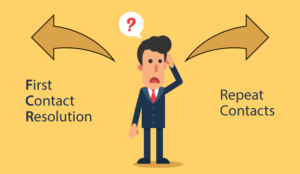When your customers reach the front of the call queue, they’re not always met by the right agent to answer their query as efficiently as possible.
That’s where smart routing comes in, pairing up customers and agents for the best possible service experience – helping to improve First Contact Resolution (FCR) rates, reduce Average Handling Time (AHT), and more.
Time to get smarter? We asked our panel of technology experts for their top tips on how to get your routing strategy off to a great start.
Here’s what they said…
How to Get Smart Routing Right First Time, Every Time
Here’s a round-up of top tips and expert insights to help you proactively connect customers with the best possible agent to answer their query:
Start by Knowing Who Your Customers Are and What They Want

There are two things you need to know to route customers effectively – who they are AND what they want right now.
“Who they are” is data that already exists in systems like your CRM. “What they want” is data that your customers supply in real time.
So first you need an automated lookup. That’s a simple automation, triggered by the incoming call, to search your customer records for relevant data. Recent interactions or purchases can signal what the current enquiry may be about.
Secondly, you need a way for customers to tell you more. In the past, this was the DTMF IVR – but that’s a limited input device which customers typically dislike. So smart IVRs (voicebots) are an increasingly common way to make the experience more open-ended for callers.
If you can nail both of those – who they are and what they want – you’re only left with the task of designing and building routing logic that puts that data to work.
Contributed by: Pierce Buckley, CEO & Co-Founder, babelforce
Jack Barton, Head of Marketing at babelforce, explains the two key ways to route calls well
Make Sure Your Smart Routing Is Supported by Smart Scheduling

Smart routing improves First Contact Resolution because calls are routed to the agents most qualified to handle each customer query.
It can also optimize occupancy and utilization, resulting in greater efficiency. However, none of that is possible unless you schedule the right agents with the right skills to be logged in at the right times.
When it comes to smart multiskill scheduling, not all WFM systems are created equal.
- Some make simplifying assumptions and handle multiskilled agents in the same way as single-skilled agents.
- Some use simulation modelling, which can deliver great results, but often requires a lot of configuration and maintenance.
- Others use advanced optimization, which can give you the best of both worlds: efficient, smart schedules, but with streamlined set-up and low maintenance.
Smart routing is here to stay, so be sure to ask your WFM vendor how it supports smart scheduling.
Contributed by: Chris Dealy, WFM Evangelist, injixo
Catalogue Issues in Your Customers’ Own Words to Make Them More Accessible
While AI-assisted routing is a great start, its real strength lies in monitoring contact drivers to ensure services and agent skills align with the evolving mix of queries.
There’s also a linguistic angle. Self-service touchpoints, IVR scripts, and even training for agents, can miss the mark if they use language that doesn’t resonate with customers.
AI can help by cataloguing issues in customers’ own words, allowing language and resources to be fine-tuned, making them more accessible and intuitive for customers.
Contributed by: Richard Gregory, Senior Sales Executive, Odigo
Set Aside Additional Time for Testing and a Phased Deployment

Testing and real-world simulations make sure the AI routes accurately – with adjustments based on metrics like resolution time and customer satisfaction.
And phased deployment based on most common scenarios allows for gradual improvement, with agent and customer feedback used to refine the system.
Ultimately it all boils down to ongoing, constant training and improvement of the system. You don’t just flick a switch and think it’s done.
Contributed by: Chris Angus, Vice President for Contact Centre Engagement, 8×8
Anticipate Future Customer Needs to Route Calls to Agents With Relevant Experience

AI works in real time to analyse each enquiry and find the best agent for the job. With skill-based matching, AI pairs customer issues with agents who have the specific expertise to solve them.
It also uses predictive analytics to anticipate future customer needs and routes calls to agents with relevant experience. AI’s natural language processing understands the intent behind enquiries, leading to smarter agent assignments.
As AI learns from past interactions, it continually improves, resulting in faster resolutions, more accurate outcomes, and a better customer experience.
Contributed by: Jonathan “Kenu” Escobedo, Customer Success Manager, MiaRec
Gather Three-Dimensional Knowledge of the Customer’s Problem to Resolve Each Issue Even Faster

Beyond basic information like queues and channels, support teams should think about matching tickets to the underlying skills that agents have. Capturing skills in your systems lets AI work together with your human agents’ strengths.
AI can quickly detect the topic a customer wants to discuss alongside the intent and sentiment surrounding that topic. That means that when a ticket is matched with the right person who has the right knowledge to solve the customer’s problem, they’ll also have a head start on how to interact with the customer.
With this three-dimensional knowledge of the customer’s problem, the issue will be resolved faster and more successfully, improving First Contact Resolution (FCR).
Contributed by: Kate Hutchinson, Product Marketing Manager, Assembled
Train AI With Historical Data to Recognize Common Issues
To train AI for smart routing in contact centres, you need to start by gathering and labelling historical data, like past interactions and customer profiles, with details on intent and outcomes.
This helps the AI recognize common issues and learn the typical resolutions. Key features such as customer intent, language, and sentiment should all be extracted, with agent skills categorized by expertise and availability for accurate matching.
Contributed by: Chris Angus, Vice President for Contact Centre Engagement, 8×8
Make Sure Agents Receive a Detailed Overview of the Customer’s Issue

We often hear about routing customers to the “best-suited agent”, but it’s a bit like the “happily ever after” in fairy tales – it oversimplifies reality.
While routing customers to the wrong department can 100% derail resolution, the true differentiator is not just where a customer ends up but the quality of information they arrive with.
AI-assisted routing can turn many skilled agents into the “best-suited” by providing a rich context.
If a customer explains their problem in their own words and completes some ID&V steps during the routing process, agents receive a detailed overview, equipping them with the insights they need to resolve issues faster and more accurately.
This contextual detail makes a real difference in FCR outcomes.
Contributed by: Richard Gregory, Senior Sales Executive, Odigo
It’s a Win–Win! Customers Are Happier and Agents Feel More Empowered

Smart routing is a great feature to ensure customer queries get sent to the right agent instantly.
This prevents bottlenecks and allows contact centres to resolve more issues on the first contact, which is critical for enhancing customer satisfaction and reducing overall call volume.
In the long run, it’s a win–win – customers are happier, and agents feel more empowered because they’re handling the queries they’re skilled in.
Contributed by: James Henderson, Sales Engineer, Puzzel
For more great insights and advice from our panel of experts, read these articles next:
- The Superhuman Touch – How to Blend Agents and AI for Maximum Impact
- What Tech Should You Buy Next? Here’s How to Choose
- Next-Gen WFM: What Is Coming Down the Line?
Author: Robyn Coppell
Reviewed by: Megan Jones
Published On: 18th Nov 2024 - Last modified: 20th Nov 2024
Read more about - Technology, 8x8, Assembled, babelforce, Call Handling, Call Routing, Chris Angus, Chris Dealy, First Contact Resolution (FCR), James Henderson, Jonathan Kenu Escobedo, Kate Hutchinson, MiaRec, Odigo, Peopleware, Pierce Buckley, Puzzel, Richard Gregory, Top Story






































